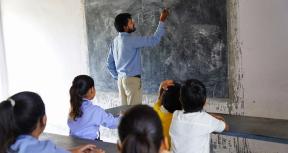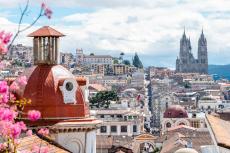As the recent One Planet Summit pivoted international attention to issues around climate and the protection of ecosystems, global leaders were eager to point to examples of successful efforts to protect and restore nature. While many efforts to stem environmental destruction have failed – and failed spectacularly – one effort, the project to plant trees across the Sahel known as the Great Green Wall, has achieved many of its envisioned technical and environmental goals. But while there is much talk of taking this successful ecosystem protection effort to scale, backed by announcements at the summit of new investments totaling US$14 billion, there is a need to learn much more about the science behind the initiative, its differentiated impacts and their costs; including the social impacts on the resource-dependent poor. Along with the achievements, there are valuable lessons to be learned about what is working and for whom that can help guide the planned scale-up.
The Great Green Wall and the World Bank
Decades ago, several African Heads of State envisioned, and eventually lent their support to, the development of a Great Green Wall: a large belt of trees that stretches across twelve states of the Sahel. The concept of the Great Green Wall was developed to combat land degradation and desertification of the Sahel, a concept that has grown in importance as the threats posed by climate change intensify. Twenty-one African countries have signed on to the initiative, along with at least 11 international partners; including the African Union, European Union, and the World Bank. The World Bank has played a contributing role over the past two decades through the Sahel and West Africa Program in Support of the Great Green Wall Initiative (SAWAP), a programmatic approach using $1.2 billion from World Bank projects and $106 million of Global Environment Facility financing “to expand sustainable land and water management in targeted landscapes and in climate vulnerable areas in twelve West African and Sahelian countries”.
The Independent Evaluation Group has evaluated a number of the projects under the SAWAP umbrella, including in Benin, Burkina Faso, Chad, Ethiopia, Mali, Niger and Togo. Some of these evaluations included site visits and extensive discussions with government counterparts and local community members to deepen understanding of the overall impact of the Great Green Wall project and Bank support for it. Our findings point to some important issues to consider when designing future projects.
The World Bank’s support for the Great Green Wall has been successful from a technical perspective. Earth observations (satellite imagery, drone footage) combined with site observations support this view. Vegetation has been successfully established, land has been rehabilitated through large commitments of labor for soil works, and the density of trees and shrubs have increased dramatically at rehabilitation sites (although observations at older rehabilitation sites suggest that these technical successes may be short-lived, due to limited funds for upkeep and necessary maintenance). Most notable amongst these positive effects is the large swaths of degraded land that have been reclaimed in critical watersheds in Ethiopia. However, a precise understanding of the change in vegetation cover across the Sahel, attributable to donor investments in the Great Green Wall, has been limited because of an underinvestment in measurement (e.g. a normalized difference vegetative index to measure the change in vegetation, recommended through a regional project by the World Bank at the beginning of the SAWAP, was never implemented). And, importantly, none of the World Bank projects estimated the effect of changing rainfall patterns on the greening effects. The misestimation of the role of rainfall variability as the key parameter affecting vegetative cover and agronomic productivity has a long history in the African drylands. Many unqualified statements have and continue to attribute Sahelian greening entirely to the actions of farmers.
But in a region grappling with food insecurity, persistent violent conflict, and rural poverty, environmental gains supported by investments in the Great Green Wall must also benefit the poor. Just prior to the coronavirus pandemic, there were 30 million food insecure people in the Sahel, and that number continues to grow. This large cohort consists of farmers, agro-pastoral, and nomadic populations – all of whom engage in traditional land-use arrangements that provide mutual food and livelihood benefits. In these settings, even the most degraded land has value: these are important areas of passage and grazing for livestock, particularly during the rainy season, and are sources of wild plants and wood gathered by women. But the use of area enclosures – a land management practice that seeks to restore degraded land by excluding livestock and humans from openly accessing it in the short to medium term – runs the risk of exacerbating vulnerability; and in the absence of good land governance, possibly causing harm. Some policymakers point to the possibility of benefits “trickling down”, but given the very moderate economic benefits of many of the SAWAP projects, that is unlikely to play out.

Credit: Rafe H Andrews, Dawning
Increasing the value of degraded land, as was done by the Great Green Wall initiative, changes the decision-making calculation of land users – with enhanced farm value, these lands can be predated upon by elites, and can lead to encroachment by non-traditional farmers which risks displacing the local population. Such was the case in sites visited by IEG in Niger, where land was effectively restored, but where parcels were also sold outside of the community, in areas that lacked good land governance. Predation also occurs as a result of decisions to support crop agriculture alongside tree planting. While land restoration activities took place on communal land, the introduction of “inter cropping” facilitated individualized claims on community land. A lesson learned is that such projects should be designed with an understanding of customary, flexible tenure arrangements and the coping strategies of vulnerable resource users who access degraded lands as a social safety net. And, importantly, that emphasis should be placed on ensuring that clear, enforceable land-use agreements are in place prior to land restoration activities, to protect the land-use rights of the most vulnerable.
Because land restoration mainly benefits those that have access to land, some women and youth are especially disadvantaged in the Sahel. In Niger, a very large number of women are forced to fend for themselves and their families because their husbands and sons have migrated to other West African countries, such as Nigeria, Côte d’Ivoire and Senegal, to look for work. This migration is often associated with a lack of access to arable land, especially for male youth. Projects that support land and resource restoration can ensure that women and youth benefit by addressing participation barriers, linked to social and cultural norms. For example, since in some conservative areas, some women’s participation in cash for work programs is prohibited, programs must propose alternative income generating options to ensure equity.
The Great Green Wall has proved to be an effective approach to reclaiming land in a region coping with disproportionate impacts of climate change. Yet rather than delivering social benefits, the planned scale up could run the risk of increasing communal tensions without careful attention paid to unintended consequences. Evidence on the impacts of the investments on both the land and communities needs to be studied carefully as a first step to ensuring the Great Green Wall leads to equitable, inclusive and sustainable development.

Credit: Nick Parisse, Dawning
Stakeholder interviews in Niger were conducted in collaboration with DAWNING.










Comments
congratulations to Lauren…
congratulations to Lauren and the team for this excellent work, which I had the great pleasure of participating in the field.
My great wish is to see how the present and future generation will preserve and reconcile this excellent green wall with the human use of land and wood which is increasing in a context of extreme poverty and climate change!
Add new comment